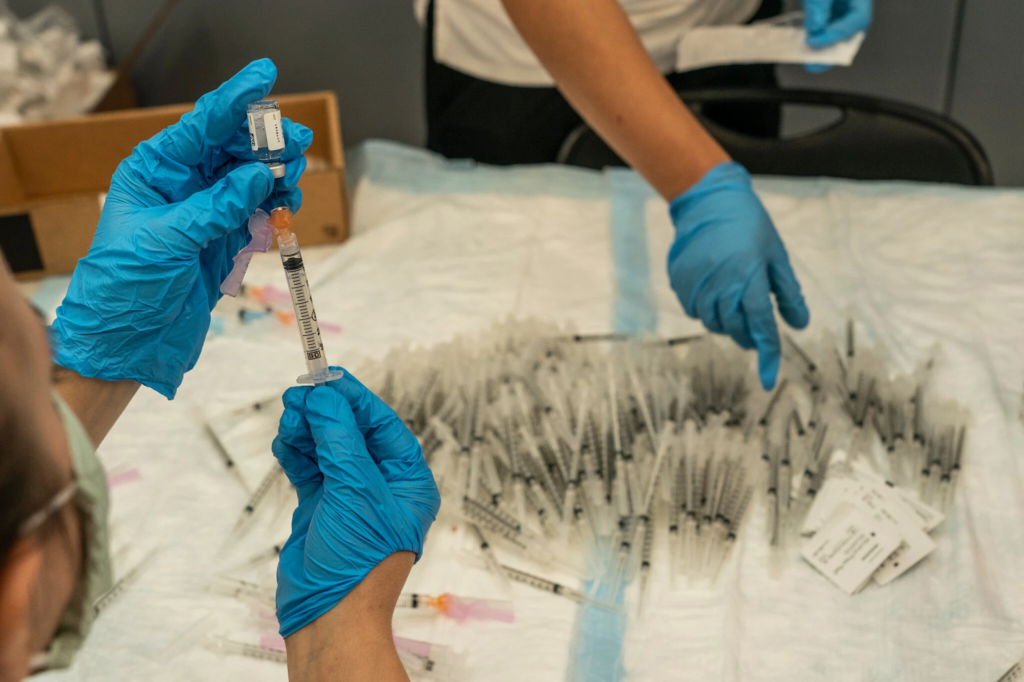Vaccination Update in the United States

Image courtesy of The New York Times
By Noelia Veras
In the United States, 63 percent of adults have received the first dose of the vaccine, and 52 percent are fully vaccinated, according to a report from the White House. The report says that since President Biden took office, cases have gone down by 90 percent and deaths by 85 percent. President Biden, however, set a goal to have 70 percent of Americans vaccinated by the Fourth of July.
Although many are optimistic about the decreasing numbers of COVID-19 cases, there is still concern surrounding the possibility of herd immunity, the sustainability of keeping COVID-19 cases down, and the likelihood of reaching vaccination goals in the United States.
According to The Washington Post, the United States reached a peak of 3.4 million shots given on one single day in April, and now the United States is averaging fewer than 1 million shots per day. This decline persists despite vaccinations being available for all adults and children over 12-years-old.
Most states on the East and West Coast have been able to get 70 percent of adults vaccinated, but rates are still falling in many areas. However, some of the steepest declines have been noted from states in the midwest and in the South. Vaccination rates in Utah, Oklahoma, Montana, North and South Dakota, and West Virginia have all fallen below 15 daily shots per 10,000 residents and in Alabama only four people per 10,000 residents were vaccinated last week.
President Biden along with many state legislators and the CDC are encouraging more people to go out and get vaccinated.
“COVID-19 vaccines are a critical tool in overcoming this pandemic,” said CDC Director Rochelle Walensky. “These benefits are another important reason to get vaccinated.”
To incentivize more people to get vaccinated California Governor Gavin Newsom helped create an incentive lottery system where vaccinated individuals could enroll in a lottery system to get the chance to win 50,000 dollars. Additionally, starting on May 27 the first 2 million people to get vaccinated received a $50 prepaid or grocery card.
“If you’re on the fence, if you’re just a little bit hesitant, or you just were unwilling in the past but all of a sudden you think, ‘I can really use $50,000,’ we’re doing all this to encourage that,” Governor Newsom said.
Additionally, according to The New York Times, many states are growing concerned about the possible expiration of the Johnson and Jhonson vaccine doses, as the White House advises states to look into the agency’s storage procedures. Pfizer and Moderna, however, are moving on to testing their vaccines on those as young as 6 months old.
Ultimately, for many people the goal is herd immunity. However, experts have estimated that to reach the threshold for herd immunity, 70 to 90 percent of the population needs to be vaccinated. It’s also important to note that even though the United States as a whole may reach herd immunity, local outbreaks are not completely out of the question, according to Samuel Scarpino, PhD, an assistant professor in the Network Science Institute at Northeastern University in Boston. Herd immunity informs us more about the possibility of a major outbreak as a result of a minor one, but it does not eliminate the possibility of infection altogether.
“It’s also not going to be the case that unvaccinated individuals are scattered around randomly,” Scarpino said. “They’re going to be clustered in the same households, same neighborhoods, and the same towns.”
Moving forward, it is clear that state governments and the federal government will continue to push for more people to get vaccinated, regardless of whether or not President Biden’s goals are reached. With the idea of herd immunity in mind, COVID-19 is far from being over, but it seems like the Biden-era protocols have allowed the United States to turn a corner in a better direction as we exit the pandemic.






